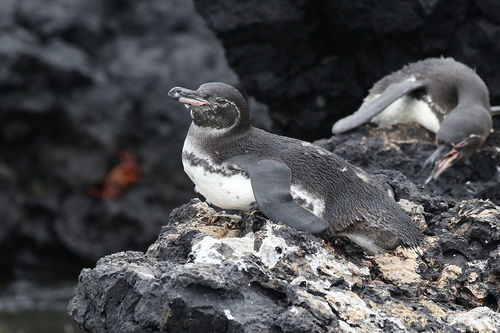
Galapagos Penguin
The Galapagos Penguin (*Spheniscus mendiculus*) is the only penguin species found north of the equator, making it a unique and fascinating subject of study. Endemic to the Galapagos Islands, this small penguin has adapted to the fluctuating, yet surprisingly cool, ocean currents that bathe the archipelago. Its presence is a testament to the unusual confluence of environmental conditions that allow a cold-adapted species to thrive in a tropical setting. The Galapagos Penguin plays a crucial role in the island ecosystem as both predator and prey, and its survival is intrinsically linked to the health of the surrounding marine environment.
48-53 cm
Length
Not typically measured for penguins; flipper length is more relevant. cm
Wingspan
Endangered
Conservation Status
Distribution
Confined to the Galapagos Islands, primarily on the western islands of Isabela and Fernandina, with smaller populations on Bartolomé, Floreana, and Santiago. They are non-migratory, remaining within the archipelago year-round.
Lifespan
Approximately 15-20 years in the wild.
Galapagos Penguin's Habitat
Habitat Types
Rocky coastlines, Lava shores, Coastal waters, Upwelling zones
Climate Zones
Tropical, Equatorial (influenced by cool ocean currents)
Adaptations
Galapagos Penguins have several adaptations to their unique environment. They utilize cool lava caves and crevices for nesting and shade during the hottest parts of the day. They also have behavioral adaptations, such as holding their flippers out to the sides to help dissipate heat and panting to cool down.
Variations
No recognized subspecies exist; however, there may be minor genetic variations between populations on different islands.
Appearance
Breeding Plumage
Plumage is generally consistent year-round, with adults having a black head and back, a white belly, and a distinctive white band running from behind the eye down to the throat. A black band also runs across the upper chest.
Seasonal Feather Changes
Juveniles have a greyer plumage and lack the distinct bands of the adults. Molting occurs throughout the year, but can be influenced by food availability.
Sex Based Plumage Differences
Minimal; males and females have similar plumage.
Notable Features
Small size compared to other penguin species., Bare skin patch around the eye and at the base of the bill, which helps with thermoregulation., Streamlined body and powerful flippers for efficient swimming.
Diet and Feeding
Primary Foods
Small fish (e.g., sardines, anchovies, mullet), Crustaceans (occasionally)
Foraging Behavior
Galapagos Penguins are pursuit divers, typically foraging close to shore in relatively shallow waters. They often hunt in groups, coordinating their efforts to herd schools of fish.
Specializations
Their streamlined body and powerful flippers allow for rapid underwater pursuit of prey. They have excellent underwater vision.
Seasonal Diet Variations
Diet can vary depending on the availability of prey, which is influenced by oceanographic conditions such as El Niño events. During El Niño, warmer waters reduce fish populations, significantly impacting the penguins.
Behavior
Social Structure
Galapagos Penguins are generally social, forming breeding colonies and foraging groups. However, they are less colonial than some other penguin species.
Communication
Vocalizations (braying, trumpeting), Visual displays (head and flipper movements)
Migration
Non-migratory; they remain within the Galapagos archipelago throughout their lives.
Territorial or Group Behaviors
Pairs defend small nesting territories during the breeding season. They often forage in groups, especially when food is abundant.
Conservation
Threats
Climate change (increased frequency and severity of El Niño events), Introduced predators (e.g., cats, dogs, rats), Overfishing (reducing prey availability), Pollution (oil spills, plastic debris), Human disturbance (tourism, fishing nets)
Protection Programs
Galapagos National Park regulations and management, Predator control programs, Monitoring of penguin populations, Research on the impacts of climate change
Local National Laws
Protected under Ecuadorian law and within the Galapagos Marine Reserve.
Population Trend
Fluctuating, with significant declines during El Niño events, followed by periods of recovery.
Population Estimates
Estimated at around 1,200 mature individuals (as of 2023).
Interesting Facts
They are the only penguin species that breeds in the tropics.
Their survival is dependent on the cool, nutrient-rich waters brought by the Humboldt and Cromwell Currents.
They can hold their breath for up to 2 minutes.
This allows them to dive and pursue prey underwater.
They are among the smallest penguin species in the world.
Their small size is an adaptation to the warmer temperatures of the Galapagos Islands.
They can experience catastrophic population declines during strong El Niño events.
These events warm the ocean waters, reducing the availability of their prey.
Faqs about Galapagos Penguin
Where can I see Galapagos Penguins?
They can only be seen in the Galapagos Islands, primarily on Isabela and Fernandina Islands.
Are Galapagos Penguins endangered?
Yes, they are classified as Endangered by the IUCN due to their small population size and vulnerability to environmental changes.
What do Galapagos Penguins eat?
They primarily eat small fish, such as sardines and anchovies.
How do they survive in a tropical climate?
They rely on the cool ocean currents, behavioral adaptations like panting and seeking shade, and physiological adaptations like bare skin patches to regulate their body temperature.
Copyright @ Nature Style Limited. All Rights Reserved.
 English
English